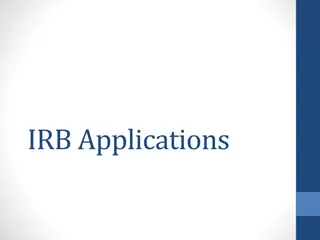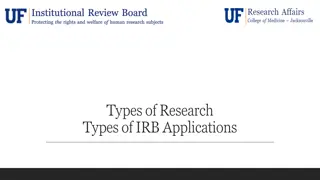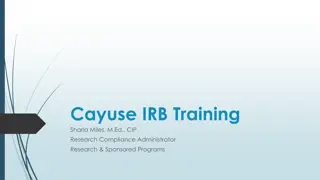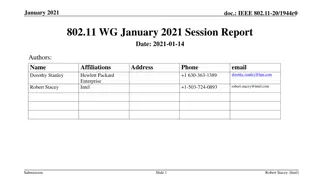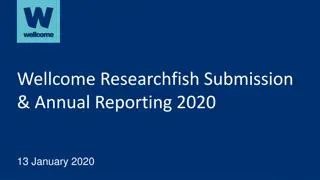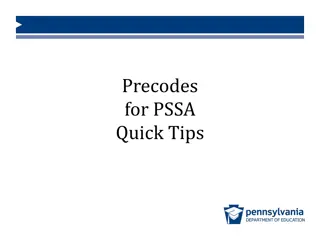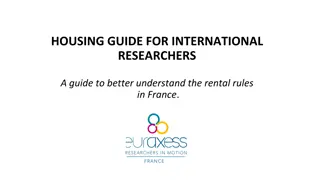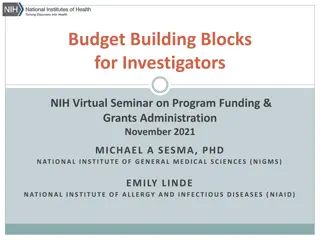First-Time Researcher's Guide: Navigating the IRB Submission Process at Barry University IRB January 2023
Providing essential guidance for first-time researchers submitting to the Barry University IRB in January 2023. Covers initial steps such as creating an IRBNet account, completing ethics training, determining the review category, and selecting the appropriate protocol form.
Download Presentation

Please find below an Image/Link to download the presentation.
The content on the website is provided AS IS for your information and personal use only. It may not be sold, licensed, or shared on other websites without obtaining consent from the author. Download presentation by click this link. If you encounter any issues during the download, it is possible that the publisher has removed the file from their server.
E N D
Presentation Transcript
Guidance for Researchers Submitting to the IRB for the First Time Barry University IRB January 2023
Objectives of this Guidance First Steps: Create an IRBNet Account Complete the Required Ethics Training Determine the Category of Review Required for Your Research Full Board Expedited Exempt Select the Protocol Form Designed for the Type of Review Your Study Requires How to Complete the Protocol Form Step-by-Step Instructions What Happens Next?
First Steps: Create an IRBNet Account Your first step is to create an account on IRBNet so you can submit research packages for review. There is a Guidance document on the IRB Website that gives detailed instructions for how to create an account. Then complete the Required Ethics Training Once you have an account, you are ready to take the required ethics trainings. There is a power point titled Guidance in CITI CERTIFICATION on the IRB Website and posted on IRBNet for detailed instructions about how to complete the ethics training. Your certificates of completion should be uploaded to your IRBNet User File so they can be easily attached to any of your packages.
Tip: Take the Correct Ethics Training Course In summary, all people working with participants and/or identifiable participant data must complete two training modules. You may take modules in Social and Behavioral Research or Biomedical Research. Please note that the modules are identical aside from the examples used so either set of modules is appropriate, but you may want to take the modules that best fit your discipline: The modules are: 1. Social and Behavioral Research-Basic Refresher course AND the Social and Behavioral Responsible Conduct of Research course OR 2. Biomedical Research-Basic Refresher course AND the Biomedical Responsible Conduct of Research course
Determine the Category of Review Required for Your Research
Determine the Category of Review Required for Your Research In order to submit the correct Protocol Form to the IRB you must determine what level of review your study requires. Your study may require Full Board Review, Expedited Review, or Exempt Review. The next few slides explain each of these categories. Please note: If your project meets Exempt review criteria it is best to submit in this category because the submission requirements are minimal, and the project will not require ongoing review by the IRB.
Submission Types: Full Board Full Board review: Full Board review is required when research: Involves more than minimal risk to participants or participants are from a protected group (specified on the Protocol form) or are vulnerable to coercion or have impaired capacity to make decisions. When any of the above-mentioned conditions are the case, the researcher must design participant selection procedures, consent procedures, and safeguards to protect the rights and welfare of participants. It is recommended that researchers attend the meeting in which their research is being discussed (schedule a remote connection with the IRB Point of Contact in the Provost s Office 305-899-3020). Submissions must be made before the first Friday of the month to be considered for Full Board review at that month s meeting. Researchers whose studies required Full Board approval are required to submit an annual report on IRBNet. Forms for the report can be found on IRBNet under Forms and Templates.
Not all Research Requires Review by the Full Board standards. Your project may meet criteria for either Expedition or Exemption as defined by federal If your research qualifies in one of these categories, it can be reviewed by an IRB member and the IRB Chair, outside of a Full IRB meeting, for faster turnaround. The criteria for Expedition and Exemption are given on the slides that follow.
Submission Types: Expedited Expedited review: The research involves no more than minimal risk to participants. Written Informed consent is obtained from each participant or the participants legally authorized representative. The research meets all the Expedited criteria listed on the Protocol Form (the form you complete to summarize your research for an IRB reviewer).
Submission Types: Exempt Exempt review: All research studies using human participants are required to have some level of review, so exempt does not mean no review it means that the research meets one of the exempt categories specified by federal guidelines for exemption (listed on the Protocol form and detailed in the Exempt Protocol Appendices). A key feature of Exempt studies is that they do not require participants to provide written informed consent but may require that the researcher inform the participant about the study in a consent-like document. For example, online research participants provide implicit consent when they read a cover letter and press a tab that says something like, If you agree to participate, click here to advance through the online experience.
Select the Protocol Form Designed for the Type of Review Your Study Requires
Complete One of the Barry University Institutional Review Board Protocol Form The Protocol Form is used to summarize your study for IRB review. There is a form for Exempt reviews (Protocol Form for Exempt Review) There is another form for reviews that are either Expedited or Full Reviews (Protocol Form for Expedited or Full Board Review) Download the most current version of this form from Forms & Templates (a menu option on IRBNet).
First Section of the Protocol Form Directions for completing the Protocol Form are embedded within the Form and clarified in this power point. The first section of the form is self explanatory and simply requires you to provide the title of your study, contact information for all researchers involved in the study, and notification if a member of your team is on the IRB (and should not be assigned the package for review).
Justify the Category of Review Your Research Meets The next section of the Protocol Form requires you to explain why your study meets criteria for the level of review you are requesting. For Exempt Reviews, select the appropriate category. Note that there is an Appendix that explains commonly used categories. There is also information in the IRBNet Library about what constitutes Action Research. For Expedited Reviews, your study must meet all the criteria listed. If your study requires a Full Board Review, simply note that on the Protocol Form.
Explain/Justify Exempt and Expedited Submissions The Protocol Forms requires researchers who are conducting Exempt or Expedited research to explain how their study meets criteria for either exemption or expedition. It is not sufficient to say, This study meets criteria 4 or This study meets all the required criteria. You must provide information to helps the IRB reviewer see why you think your study meets criteria. For example: This study meets exemption criteria 2 because adult participants will be asked to consent to completing a demographic form and 3 questionnaires. None of the questionnaires contain sensitive questions.
Tip: Create Your Informed Consent Document Before Completing the Protocol Form Much of what is reported next on the Protocol Form is identical to the information that should be in your Informed Consent Documents. There should consistency between your Informed Consent and your Protocol Form, so if you create your Consent Documents beforehand, you can cut/paste from those documents. Please note that there is a Guidance Power Point with instructions for how to complete Consent and Recruitment Documents. It may be found on IRBNet and on the Barry IRB Website.
Describe Risks to Participants The Protocol Forms require researchers to state the level of risk to those who participate in their study. Exempt and expedited research must involve no more than minimal risk. A commonly accepted definition of minimal risk is that the risk of harm anticipated in the proposed research is not greater (considering probability and magnitude) than those ordinarily encountered in daily life or during the performance of routine physical or psychological examinations or tests. If a study involves the possibility of greater than minimal risk to participants, it must undergo Full Board review. A commonly accepted definition of greater than minimal risk is that the probability and magnitude of harm or discomfort to participants are more than minimal. Research involving greater than minimal risk requires safety monitoring. Researchers must explain the surveillance and protections they will have in place to minimize harm to participants.
Information About Your Intended Participants The next section of the form ask questions related to your participants and how they will be recruited. Who will be your participants? Are they considered vulnerable? How many participants will you use? How will you recruit participants? The slides that follow help you to accurately report this information.
Vulnerable Populations The Protocol Forms requires you to report if your participants will be people who are considered vulnerable (Minors; Fetuses; Abortuses; Prisoners; Pregnant women; People with intellectual disability; Institutionalized persons) If you are planning to use participants from any of the categories listed on the Protocol Form, you must explain how you will ensure their protection. For example, when conducting research with minors you should obtain parental consent (or employ parental notification) and obtain child assent.
How Many Participants Will You Use? Provide the number of participants you will use. It is a good idea to anticipate more participants than what you need for data analysis because you are likely to have attrition and/or unusable data. The number of interest to the IRB is the number of people who may be exposed to your study, not the number you need for data analysis. The maximum number of participants that will be recruited is 150. You might add, This allows for an adequate sample while also accounting for attrition and incomplete or otherwise unusable data. FYI: The IRB wants to know the number of participants who will be exposed to your study because when assessing the costs versus the benefits of a study the IRB reviewer takes into consideration how may people will potentially be affected.
How Will You Recruit Participants? When completing the Protocol Forms, state clearly how you are going to find participants. A flyer advertising the study will be posted in the break rooms of the two hospitals where participants will be recruited. A letter introducing the study and asking for participants will also be sent to nurses via the American Nursing Association. Remember to upload your recruitment materials to your IRB package. These documents should be attached separately from the Protocol Form (as opposed to adding them as Appendices).
Research Methods and Instruments/Measures This is arguably the most important section of the Protocol Form because the IRB must be able to clearly understand what you will require of participants in terms of: What you will ask them to do How long it will take What instruments/measures/tests you may ask them to complete The slides that follow help you to accurately complete the Research Methods and Instruments/Measures sections of the Protocol Forms.
Research Methods The Research Method section of the Protocol Forms is where you specify, step by step, what will happen to your participants. Include the total time commitment required of participants and be sure you report the time consistently throughout your documents. For example, you might itemize each step like so: This study takes place online, so participants will provide passive consent in the form of a Cover Letter After consenting, they will complete a Demographic Questionnaire created for the study They will then view 1 of 4 pictures of a psychotherapist s office and asked to rate the office on a Likert scale with anchors cold to warm Finally, participants will be asked to imagine the therapist who works in the office they saw, and complete the Psychotherapist Qualities Inventory The expected time commitment is no more than15 minutes
Instruments and Measures You Plan to Use If your study involves the use of questionnaires, tests, videos, and so forth list them on the Protocol Form. Include a statement verifying that the instruments are in the public domain and therefore eligible for use without author permission. You should also note whether any instrument asks sensitive questions (e.g., questions that ask about mental or physical health symptoms or abuse) If you are using an instrument that asks sensitive questions, include a statement on your Consent Form (and on the Protocol Form) that indicates the steps you have taken to minimize participant distress. For example: One inventory used in this study asks about symptoms of depression. If you find that completing this inventory raises your concern or distresses you, please contact the CRISIS LIFELINE (1-800-273-TALK or 988LIFELINE.ORG)
Does Your Study Involve Research on Existing Barry Programs? If you are researching a Barry program, you must notify the Office of Institutional Research. Indicate on your Protocol Form that you have done so. Identify the program you are researching.
Anonymity/Confidentiality Statement The next section of the Protocol Forms asks you to explain how you plan to protect the anonymity and confidentially of participants. The slide that follows provides suggests. Please note that you should note cut and past all the suggestions, but rather select and edit items that fit with your study. For example, if you are not using focus groups or audio recordings, you should note reference those items.
How Will You Obtain Participant Consent? Most studies require that participants complete an Informed Consent document. There is an Informed Consent Content Checklist in the IRBNet Library that specifies all the elements required. You may also use the Consent Form Templates created by the IRB. They are posted on IRBNet under Forms and Templates Please also see the Guidance for Creating Informed Consent and Recruitment Documents for Research posted on the IRB Webpage and on IRBNet under Forms and Templates
Conflict of Interest A conflict of interest refers to circumstances where a researcher has a personal connection to what is being researched that may compromise or appear to compromise the researcher s judgement in conducting or reporting research. For example, a researcher conducting an evaluation of a company for which he/she/they has a financial interest.
Third Party Confidentiality Agreement If you will use another person or agency to work with your data before it is deidentified, you must have a confidentiality agreement with the entity. For example, you will need an agreement if your data consists of recorded interviews, and you plan to hire someone to transcribe the recordings.
Verify Your Package Signature Note that electronically signing your IRBNet package confirms the following: I certify that the information on this protocol, as approved by the Institutional Review Board (IRB), will be followed by all members of the research team. I will submit any modifications for IRB review and approval prior to implementation. I will immediately report to the Barry University IRB Chair any adverse events for human participants in this study. As defined by the federal standards, adverse events can be physical, psychological, social, or methodological (e.g., neglecting to obtain informed consent). For student projects: I certify that my faculty sponsor has reviewed and approved this protocol for submission.
Additional Elements on the Protocol Form for EXPEDITED or FULL BOARD Reviews If you are completing the Protocol Form for Exempt review, skip to slide 36 The following elements are part of the Protocol Form for Expedited or Full Board review: Benefits Statement Future Use of Data Statement Report a Funding Agency or Research Sponsor Report Drug/ Medical Device/ Radiation/ Radioisotope Research The slides that follow provide guidance for completing these sections
Benefits Statement The EXPEDITED and FULL BOARD Protocol Form require that you make statements regarding the benefits associated with the study. It is often the case that a study does not directly benefit participants, and this should be stated. The research should, however, be of benefit to someone so a statement about how the finding could be used is appropriate to add. Note that this information is required on consent documents, so you may simply cut and paste from the consent document to the Protocol Form. Example of how to phrase the benefit statement on the Consent document: There are no direct benefits to you for participating in the study. Although there may be no direct benefit to you, the research will help us learn more about
Future Use of Data Statement The EXPEDITED and FULL BOARD Protocol Form require that you make a statement about whether the data will be used in the future. Note that this information is required on consent documents, so you may simply cut and paste from the consent document to the Protocol Form. Example of how to phrase the future use of data statement on the Consent document: The data with identifiers removed--may also be used in future research or distributed to another investigator without additional informed consent. The data will not be used or distributed for future research studies.
Report a Funding Agency or Research Sponsor The purpose of reporting funding sources and other forms of support for your research is that the IRB needs to consider whether obtaining funds from an agency or other support creates a conflict of interest for the researcher. Additionally, this information should be part of your informed consent documents. Disclosing this information allows participants to opt out of research funded or supported by an entity they find problematic.
Report Drug/ Medical Device/ RadiationResearch Reporting whether your research involves these medical products is required because the Food and Drug Administration (FDA) may have to be notification prior to collecting data.
Final Steps When you have completed your Protocol Form, upload it to your IRBNet package. Documents related to the study should also be uploaded -- as separate items (i.e., participant recruitment materials, Consent Forms, other materials if required by type of submission) All members of the research team who will have contact with participants and/or identifiable participant data must upload their ethics training certificates to the package. Committee members that will not manage data do not have to be listed. Lastly, the package must be electronically signed by the primary researcher/investigator (PI) and the PIs faculty sponsor (if applicable). When there is a faculty sponsor, that person s signature indicates that he/she/they have reviewed and approved of the research and all the documents in the package. Documents that are not screened for accuracy, typos, and required content should not be submitted for IRB review. Faculty may sign for students, but students may not sign for faculty.
What Happens Next: A Full Board Review Either you or an IRB reviewer notes that the study requires a Full Board review The IRB Chair verifies that the study requires a Full Board review The study is scheduled for review at the next IRB meeting Step 1 Step 2 Step 3
What Happens Next: An Expedited Review OR an Exempt Review You justify on your Protocol that your study meets criteria for Expedited or Exempt status. The IRB contact person assigns your package to an IRB member for reviewer Step 1 Step 2 Step 3 The IRB member reviews the study within 1 week and notifies the IRB Chair of the review outcome The IRB Chair writes a letter to you reporting the review outcome (Approval, Required Revisions, or Rejection)


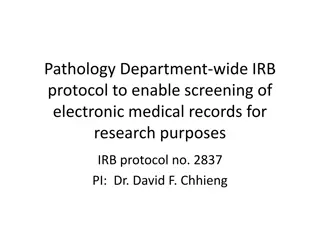

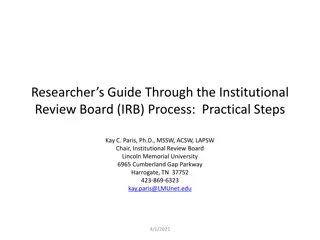
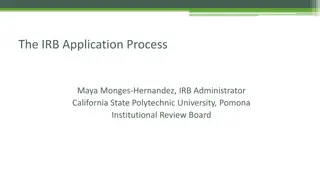


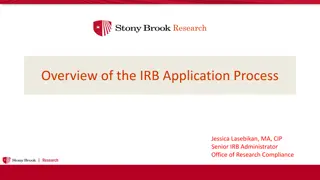
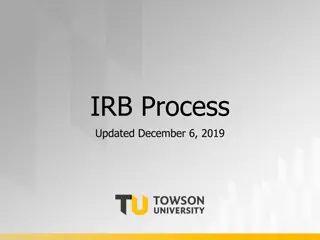
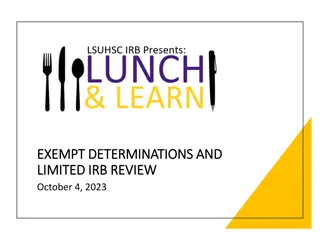
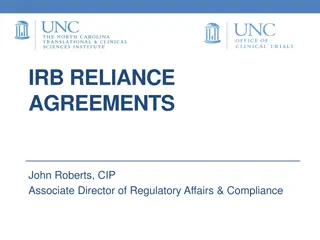
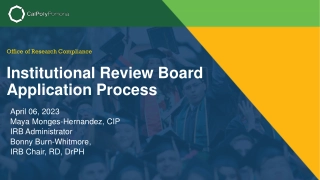


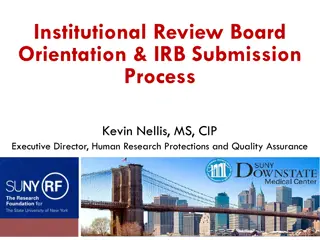



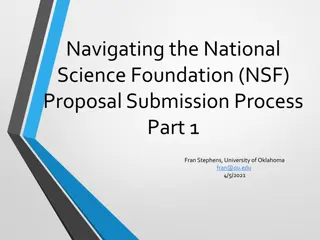
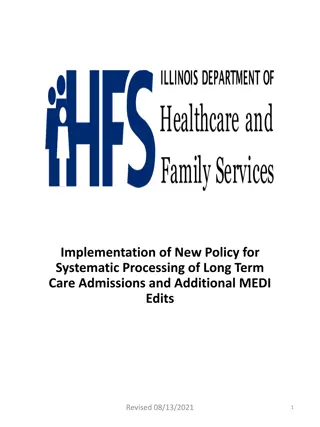
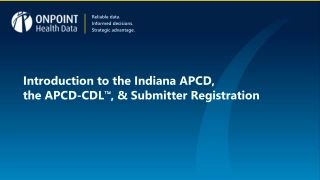

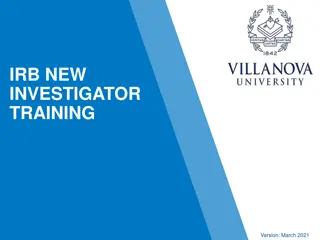
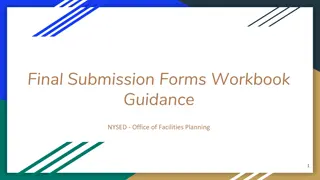
![ANC Women's League Oral Submission on Expropriation Bill [B23.2020]](/thumb/136076/anc-women-s-league-oral-submission-on-expropriation-bill-b23-2020.jpg)
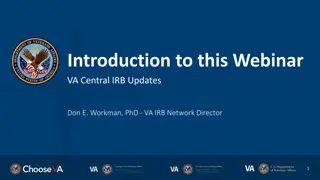
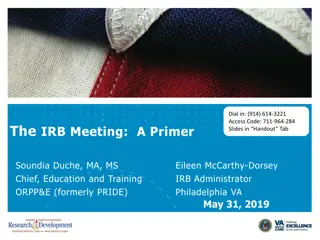

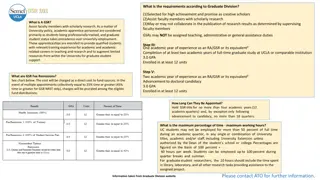
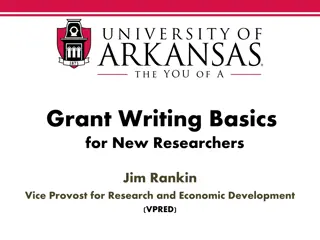
![Comprehensive Overview of Corruption Watch Submission on Public Procurement Bill [B18B-2023]](/thumb/138344/comprehensive-overview-of-corruption-watch-submission-on-public-procurement-bill-b18b-2023.jpg)
